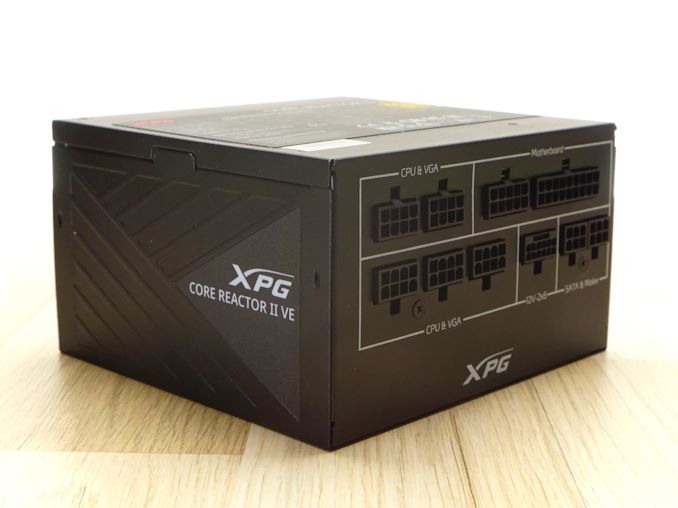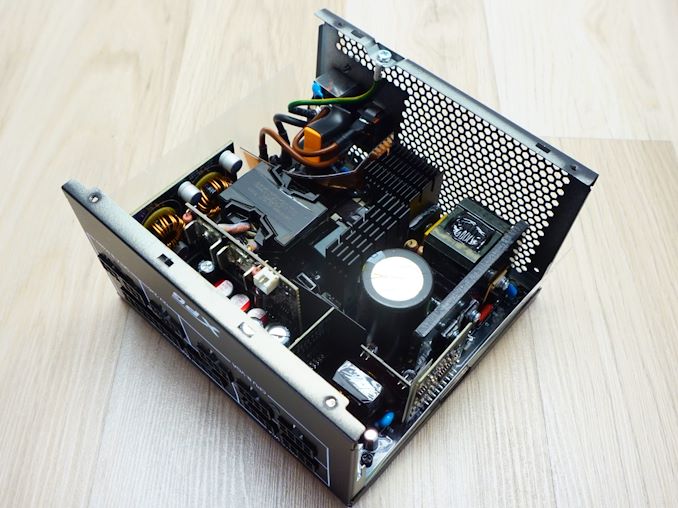The XPG Core Reactor II VE 850W PSU Review: Our First ATX 3.1 Power Supply
by E. Fylladitakis on May 2, 2024 10:00 AM EST- Posted in
- Cases/Cooling/PSUs
- PSUs
- 80Plus Gold
- XPG
- ATX v3.1
Power Supply Quality
The electrical performance of the XPG Core Reactor II VE 850W PSU is competent, with effective voltage regulation across its outputs. However, ripple suppression on the 3.3V and 5V lines shows room for improvement, characterized as mediocre compared to industry leaders. The 12V rail exhibits a maximum ripple of 56 mV, and the ripple on the 5V and 3.3V lines measures at 38 mV and 34 mV respectively, indicating less stringent control compared to some high-end models. Despite this, the PSU maintains stable operation and matches the performance ratings advertised by the manufacturer.
| Main Output | ||||||||
| Load (Watts) | 172.03 W | 429.42 W | 642.42 W | 855.98 W | ||||
| Load (Percent) | 20.24% | 50.52% | 75.58% | 100.7% | ||||
| Amperes | Volts | Amperes | Volts | Amperes | Volts | Amperes | Volts | |
| 3.3 V | 1.99 | 3.3 | 4.97 | 3.3 | 7.45 | 3.28 | 9.94 | 3.28 |
| 5 V | 1.99 | 5.06 | 4.97 | 5.05 | 7.45 | 5.04 | 9.94 | 5.04 |
| 12 V | 12.79 | 12.15 | 31.98 | 12.13 | 47.97 | 12.1 | 63.96 | 12.09 |
| Line | Regulation (20% to 100% load) |
Voltage Ripple (mV) | |||||
| 20% Load | 50% Load | 75% Load | 100% Load | CL1 12V |
CL2 3.3V + 5V |
||
| 3.3V | 0.5% | 14 | 24 | 30 | 34 | 18 | 32 |
| 5V | 0.3% | 12 | 20 | 26 | 38 | 16 | 28 |
| 12V | 0.5% | 16 | 26 | 32 | 56 | 48 | 30 |
During our thorough assessment, we evaluate the essential protection features of every power supply unit we review, including Over Current Protection (OCP), Over Voltage Protection (OVP), Over Power Protection (OPP), and Short Circuit Protection (SCP). The XPG Core Reactor II VE 850W PSU passed all critical protection tests, proving its capability to safeguard against scenarios that could compromise the PSU or connected components. The unit showed slightly loosely calibrated Over Current Protection (OCP) for the 3.3V and 5V rails, activating at 136% and 138% respectively, which is high but remains within acceptable limits. The 12V rail’s OCP activation at 146% is extremely high but we are not surprised considering the need of manufacturers to comply with the power excursion design guide requirements.
Conclusion
The XPG Core Reactor II VE 850W PSU distinguishes itself as the first ATX 3.1-compliant unit from XPG, setting a benchmark in the power supply landscape with its adherence to the latest standards. Priced at an MSRP of $119 and likely to retail for significantly less, this power supply unit blends high-quality performance, robust construction, and a price point that appeals to a broad spectrum of users. Manufactured by the reputable Channel-Well Technologies, the unit benefits from expert craftsmanship, enhancing its durability and ensuring it stands up to the rigors of daily use. The provision of a 7-year warranty by XPG further emphasizes their confidence in the PSU's long-term reliability.
In terms of performance, the XPG Core Reactor II VE 850W does very well, achieving impressive efficiency ratings that greatly exceed the requirements for 80Plus Gold certification, recording average nominal load efficiencies of 90.9% on 115 VAC and 91.7% on 230 VAC. Power quality is great too, with fantastic voltage regulation on all lines and good filtering on the primary 12V line. Despite its strengths, it is worth mentioning that the unit does exhibit only moderate ripple suppression on the 3.3V and 5V lines, which may be adequate but not on par with other high tier products.
Thermal management in the Core Reactor II VE is acceptable, mostly thanks to its powerful 120 mm fan, which effectively dissipates heat across varying loads. However, the unit's electrical performance does show signs of degradation under extreme conditions due to thermal stress, particularly when operating near full capacity in higher ambient temperatures. This aspect is crucial for users to consider, especially those in warmer climates or with high-load applications, as it impacts both performance and noise levels, with the latter increasing significantly under heavy loads.
In conclusion, the XPG Core Reactor II VE 850W PSU is a significant release, being the first to meet ATX 3.1 specifications, seemingly offering forward-looking compatibility with next-generation hardware. The balance of cost, capabilities, and the extended warranty make it an attractive option for a wide range of users, from gamers to professional workstation builders. While it performs admirably across most parameters, potential buyers should weigh the implications of its poor performance under adverse operating conditions. Still, its performance metrics under typical operating conditions and quality make it a worthy investment for those who want a balanced product that does not break the bank.












31 Comments
View All Comments
Reflex - Friday, May 3, 2024 - link
Tesla announces a lot of unverifiable things. No point in doing their PR for them. Replyzodiacfml - Saturday, May 4, 2024 - link
true but they can revolutionize efficiency in datacenters as they have existing solar and battery products and services. it's just a matter of scale which is likely the cause of delays, like they can't simply ask Nvidia to make 48 volt power AI graphics cards-unless Tesla buys so much or convince other tech giants to go 48V ReplyTheinsanegamerN - Monday, May 6, 2024 - link
That would require sweeping industry wide changes and break decades of compatibility. Fat chance that happens. Replyballsystemlord - Thursday, May 2, 2024 - link
@Ryan , the "hot box testing" section has 2 images of the conversion losses and 0 images of the fan curve. Please fix this. Thanks! ReplyRyan Smith - Friday, May 3, 2024 - link
D'oh! Thank you for catching that.Unfortunately that's a problem with the image itself (right image, wrong data), and needs to be regenerated by hand. So I'm not able to immediately fix it. I'll have Tracy upload the correct one as soon as possible. Reply
Ryan Smith - Saturday, May 4, 2024 - link
And fixed. Replywr3zzz - Thursday, May 2, 2024 - link
What's the safest way to use previous gen 1000W PSU for RTX4090/5090? ReplyrUmX - Friday, May 3, 2024 - link
For 5090, we don't know. That GPU didn't release yet. ReplyRyan Smith - Friday, May 3, 2024 - link
Make sure the cable you're using is making very good and tight connections at both ends.If there is a problem, it's much more likely to occur on the video card end of things, and those are already by and large using the new 12V-2×6 connector since it's such a quick swap. Reply
shabby - Friday, May 3, 2024 - link
Keep a fire extinguisher close by... Reply